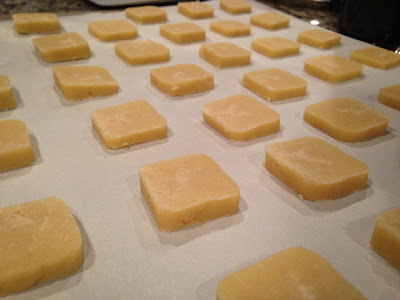I saw a recipe on Pinterest for some lemon tea cookies with frosting on top about a week ago, and I got super excited to make them. But after looking over some of the comments on the recipe, I saw that many people complained that the cookies fell apart after baking and crumbled into a total mess. The recipe for the cookies contained no egg or other emulsifier, so my guess is that the dry ingredients weren't willing to stick to each other through sheer force of will.
However, I wasn't willing to give up on my lemon tea cookie urges, and I found a more promising recipe from Taste of Home. I almost gave up making them today, because the delicious lemon frosting filling required powdered sugar, which I did not have on hand. Luckily, the internet came to the rescue and told me I could make my own!
Turns out, powdered sugar is just mashed up sugar with some cornstarch. For however much powdered sugar you want, just place that much granulated sugar in a blender and blend on high for however long it takes to become powder. (These are some extremely technical directions, people. I hope you appreciate my genius.) And after some maniacal laughter and loud blender noises... voila!
Then, add 1-2 tablespoons of cornstarch for each cup of sugar. The cornstarch is optional, but great for frostings where you might want to thicken a mixture for some structure. If you don't have cornstarch, why the heck not?! Have you seen this? Or this? Science demands that you have this at all times!
I mixed the powdered sugar into a mixture of butter, lemon juice, and lemon zest to make this beautiful delightfulness.
 |
| Lemony goodness... |
The cookies themselves were crazy simple. Cream together softened butter and sugar, beat in an egg yolk and vanilla, then mix in flour. You'll get a pretty nice dough that looks like this.
Then form it into a square-shaped roll, wrap it in clear plastic wrap, and store it in the fridge for a few hours.
 |
| Be thankful I'm not majoring in architecture |
The recipe said to leave the two rolls in the fridge overnight, but that would imply I have some amount of patience. (I swear I can hear my mother laughing 3000 miles away...) It seemed that 3-4 hours was plenty. So after a few House of Cards episodes, I cut the very solid dough into 1/4 inch thick squares.
Then I popped them into the oven for 10 short minutes, and the rest is history!
Adjustments / Substitutions
I didn't have any oranges on hand, so instead of adding orange zest to the filling, I added lemon zest. This made it super lemony, which I don't think is a bad thing, but I'd love to try it with the orange flavoring.
Next Time
Aside from using orange zest instead of lemon zest, there's not much else I could change. I don't think my powdered sugar is as finely ground as store bought powdered sugar, so I don't think I would regularly make my own. Having even a semblance of granules in the filling makes it a little bit less smooth, and I want all the texture focus to be on the cookies themselves.


























